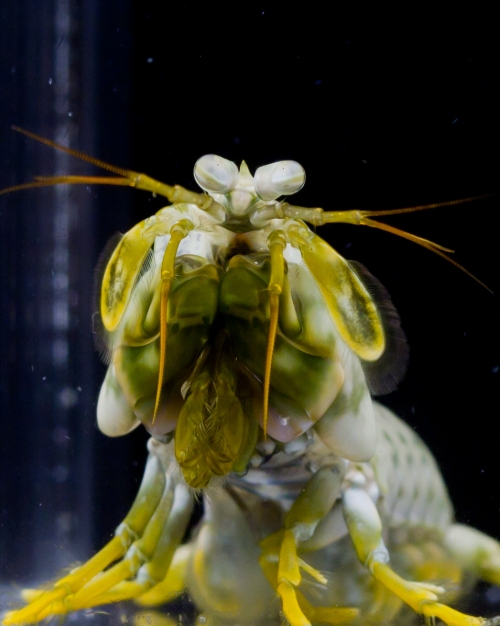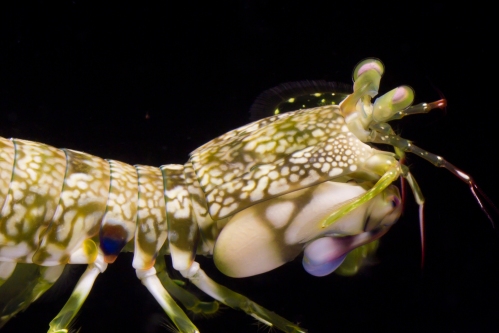
Photo: John Sellers
Here is yet another arthropod photo that gets a lot of attention around the internet (and in hysterical mass emails from your aging relatives). During the recent deployments, US servicemen started running into these unsettling arachnids, commonly called camel-spiders, in the Iraqi desert. They subsequently sent home a good deal of photos, rumors, and urban legends about them. To the left is the most popular camel-spider photo that is circulated around the web. Claims about these arachnids include (according to
Snopes.com):
- They are extremely aggressive, viscously charging directly towards, and pursuing soldiers.
- Running up to 25 mph whilst making a screaming sound.
- They can grow to be as large as dinner plates.
- They are able to jump several feet in the air.
- They are venomous and can anesthetize their prey while they chow down unnoticed.
- They eat, live in, or lay their eggs in the bellies of camels.
Unsurprisingly, most of this is nonsense fueled by exaggeration, misunderstanding, and wild speculation. Let’s dispel these myths and learn about the interesting reality of Solifugid biology.
Alternately referred to as sun spiders, wind scorpions, and camel spiders; members of Solifugae are neither spiders, nor scorpions, belonging to a distinct evolutionary lineage within the arachnids.
Most Solifugids are highly specialized for survival in arid habitats and they are found in deserts around the world, excluding Australia. They are mostly nocturnal to avoid the heat, but some species are diurnal. Shade is crucial to the survival of arid solifugids that are active during the day. The reports of camel spiders charging and pursuing soldiers are likely derived from the animals attempting to take refuge from the sun in their shadows. As far as the shrieking sound that they allegedly make during their charges: Perhaps the sound actually comes from the men, who later try to save face in front of their buddies by attributing the noise to the arachnid. I can relate.
One of the most obvious physical characteristics of solifugids are their massively enlarged chelicerae. These appendages give the impression of tremendously engorged, venom-laden fangs. However, their size is actually a compensation for a lack of venom (There is a single Indian species, Rhagodes nigrocinctus that may possess venom glands, but this has not been well confirmed and there is no known injection mechanism). Each of the chelicerae are composed of two segments forming powerful pincers. These pincers are used to grasp and tare apart their prey; which includes other arthropods, lizards, snakes, and possibly small mammals. Solifugids do not feed on animals larger than themselves, and they do not munch away on humans or camels, unnoticed through the use of anesthetic venom. If these guys take a chomp out of you, you will notice. However, they are not particularly aggressive to people unless harassed or backed into a corner.
Unlike spiders and scorpions, solifugids superficially appear to possess ten legs. However, the largest, foremost ‘legs’ are actually enlarged, antennae-like, sensory appendages, called pedipalps. The pedipalps are also used for climbing and prey capture.

Galeodes arabs, redrawn by Richard Fox, from Savory, 1977.
Additionally, the first set of true legs are also used as accessory sensory appendages, leaving only the back three sets of legs for locomotion. Solifugids are nonetheless capable of quick bursts of speed (up to 53 cm/sec or 1.2 mph) when attacking prey or darting for cover. However, the claims that they can travel at 25 mph and keep pace with Humvees are obvious exaggerations.
Now, to address the ‘size of dinner plates’ claim about solifugids, which is reinforced by the popular image at the top of the article: Amazingly, for these sorts of meme inducing images, I was actually able to track down the photo’s origin. According to Paula Cushing, Department Chair and Curator of Invertebrate Zoology at the Denver Museum of Nature and Science, the photo was taken by a serviceman and amateur photographer named John Sellers. He photographed the two animals, one violently clamped onto the others abdomen, following a gladiatorial battle between the two solifugids staged by the soldiers (an ugly practice that has gone on at least since British troops were stationed in Egypt during the first World War, and continues today in Youtube videos). Though I was unable to determine an exact species ID, the pictured solifugids are members of the Galeodes genus (perhaps G. granti or G. arabs?). They are about 10 cm in total length, residing at the upper end of the solifugid size spectrum, which ranges from 1 cm to 10 cm in body length. The largest example of a solifugid I could dig up is this Galeodes fumigatus, which appears to be about 11 cm or more in body length. So these animals can reach a menacing size, but nothing close to a dinner plate, or the size suggested by the tricky perspective of the camel-spider meme photo.
Some solifugids can be large and creepy-looking, to be sure, but they are not the deadly, bloodthirsty, lightning-fast, venom-dripping, monsters that popular culture has portrayed them as. If you can redirect fear and revulsion into fascination, and look beyond the unsettling facades of monstrous arthropods, you may find a vibrant wealth of astonishing realities.
–
Previous posts about arthropods in popular culture:
References:
Thanks to Paula Cushing and Mark Harvey for additional assistance.


































